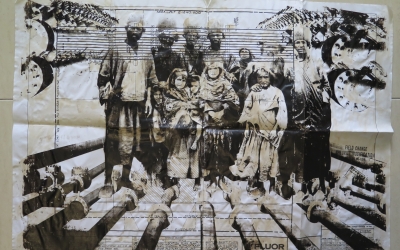Andy Warhol in Iran - rethinking the absurd

Why are we supposed to be shocked, or at least taken aback, or else think it bizarre, if not absurd, when we encounter apparent cognitive dissonance in the titles of creative work?
Currently in the US, there is a play running called Andy Warhol in Iran, which is a fictional take on an actual historical event. What was Warhol doing in Iran - of all places?
A few years ago, at the height of the Bush administration's “War on Terror”, and during the heyday of neocon influence over US foreign policy, a book called Reading Lolita in Tehran by Azar Nafisi, an expat bourgeois feminist, became a national and international bestseller. The book cast young Iranian women as incarcerated harem damsels waiting to be liberated by Bush and the US Marines, free thereafter to enjoy “western literature”. How could you read Lolita (of all things) in Tehran - among all those Muslim fanatics?
What was Warhol doing in Iran - of all places?
By no means do these two examples reflect identical politics. But they do both invoke the oddity of icons of “western” art and literature finding their way into an outlandish domain codenamed “Iran” or “Tehran”.
Andy Warhol in Iran is a dramatic account based on an actual event when, at the height of his fame as a revolutionary pop art icon, Warhol visited Iran in 1976, following an official invitation to carry out a portrait of Queen Farah Pahlavi.
New MEE newsletter: Jerusalem Dispatch
Sign up to get the latest insights and analysis on Israel-Palestine, alongside Turkey Unpacked and other MEE newsletters
Here though we see an unreal encounter between the artist and a revolutionary activist, who wants to kidnap Warhol to gain publicity for his cause. Something like Hector Babenco's classic 1976 movie Kiss of the Spider Woman seems to be at work here.
'Culture industry'
Warhol (1928-1987) was an American visual artist who emerged as a leading figure in pop art. In that medium, he staged and accentuated the glitzy mixture of advertising and celebrity culture, on the borderlines between exaggeration and celebration, carried ad absurdum.
He would be the prime player in what the leading German philosophers of the time, Theodor Adorno and Max Horkheimer, labelled "the culture industry”.
In July 1976, following an official invitation from the Pahlavi palace, Warhol went to Iran, where he would take a picture of Queen Farah with his iconic Polaroid camera, from which he would do his portrait.
He had done similar portraits of such diverse figures as Marilyn Monroe and Mao Zedong. Politics did not matter to Warhol. “Celebrity” culture did.
Warhol’s biographer Bob Colacello has given a detailed account of their visit to Tehran, where Warhol spent much of his time at the Hilton Hotel, drinking copious amounts of champagne and eating much caviar. He was said to be not remotely interested in the country he was visiting and was constantly complaining about the heat.
According to Colacello, Warhol “was fascinated by world leaders” and other than the queen of Iran had done a portrait of Golda Meir and wanted to do Imelda Marcos, too.
From Colacello we learn that Warhol was very much in his own world and could not care less if he was in Iran, Mexico, Paris or New York, as long as he was able to fine-tune his pop vision of things.
Superficial and the powerful
There is nothing right or wrong with Warhol’s approach. He had found a niche in the global art market of consumer capitalism and celebrity culture - and he was an accurate purveyor of that historical moment. He was even the target of an assassination attempt by a radical feminist, who suspected Warhol had stolen her manifesto.
Andy Warhol in Iran's writer, Brent Askari, says that Warhol’s real-life encounter with Iran's ruling royal family was not dramatic enough. Hence his fictional encounter with a cliched “revolutionary” and a plot to kidnap Warhol while he was in Iran.
“It wasn’t Warhol’s celebrated pop-art images that intrigued Maine-based playwright Brent Askari,” we read. “It was instead Warhol’s affinity for dictators - specifically the artist’s 1976 visit to Tehran as the guest of the late Shah Reza Pahlavi, an authoritarian ruler who imprisoned and tortured critics of his regime.”
Serendipitously, the play speaks to the current events in Iran, where the son of that very same shah has laid a renewed claim on his father’s throne.
Warhol’s attraction to the rich and powerful, including the shah of Iran and his family, as well as other celebrities such as Mick Jagger, Liza Minnelli, John Lennon, Diana Ross and Brigitte Bardot, was both good business and symptomatic of his abstraction of the superficial and the powerful - the fusion of which he had made an art form.
Thus his trip to Iran was so banal and cliche-ridden that it fitted perfectly with his art.
Perhaps one of the greatest episodes of contemporary modern Iranian art was happening right under Warhol’s nose and yet he remained entirely oblivious to it. He could not have cared less who Hossein Zenderoudi was, or Nikzad Nodjoumi, or Parviz Tanavoli, or scores of other artists around them.
He had his own vision of things formed remotely in the provincial plenitude of American consumerism and pop politics that eventually gave the US and the world Donald Trump - the ultimate kitsch president, deeply rooted in US celebrity culture.
Reactionary nostalgia
A significant segment of the current upspring in Iran deeply identifies with the Pahlavi era into which Warhol made a brief appearance. The reactionary Pahlavists’ nostalgia for the ancien regime is emblematic of an Iranian society ready to try a rehashed version of the banal and brooding Pahlavi regime.
Today, Iran is in a miserable state with runaway inflation, impoverished provinces and environmental calamities wreaking havoc.
The reactionary nostalgia for the ancien regime is emblematic of an Iranian society ready to try a rehashed version of the banal and brooding Pahlavi regime
The former Pahlavi queen had a taste for modern and contemporary European and American artists - with Warhol just one of them - and a wealth that meant she could indulge her taste. The artworks she collected remain in Iran.
The fundamental problem of contemporary and modern art history is the fact that it is primarily formed on the self-centred, capitalist paradigm that had occasioned it on a centre-periphery model.
And that periphery, thus designated, never had either the aesthetic courage or the theoretical audacity to self-theorise beyond reactive if not reactionary terms.
Now that would be a revolutionary icon, visiting the memory of Andy Warhol in his hotel room choking on “Persian” caviar.
The views expressed in this article belong to the author and do not necessarily reflect the editorial policy of Middle East Eye.
Middle East Eye delivers independent and unrivalled coverage and analysis of the Middle East, North Africa and beyond. To learn more about republishing this content and the associated fees, please fill out this form. More about MEE can be found here.







